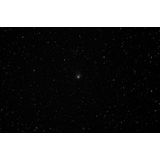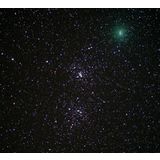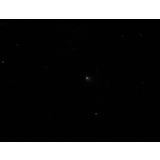
At one time, comets were referred to as dirty snow balls. Then they became known as dusty ice balls. Now they are considered icy rock balls. No matter what set of adjectives you use to describe them, what we have learned recently is that comets are as individual as, well, individuals!
Astronomers have hypothesized that comets began their lives as part of the solar nebula and orbit the Sun in two distinct periods — long or short. Comets which have short orbital periods are thought to come from the Kuiper Belt, an area of the Solar System beyond the planets, extending from the orbit of Neptune and similar to the asteroid belt. Comets with longer orbital periods may originate from the Oort Cloud, a suspected region of comet bodies that's located about a light year from the Sun. These comets might have orbital periods which last hundreds, or even thousands, of years, and some may just take a direct route towards the Sun when nudged by the gravity of the larger planets or a wandering star. There are even a handful of comets — hyperbolic — which make only one pass through our Solar System before being flung out into deep space.
Periodic comets which have an established orbital period of less than 200 years have the designation "P/" added to their name. For example, Halley's Comet is officially designated as 1P/Halley. This means it is the first periodic comet discovered and it was named after its discoverer, Edmund Halley. Non-periodic comets — or ones for which an orbital period hasn't yet been confirmed — are designated with "C/". Many non-periodic comets are located and named for the equipment which reveals them, such as ones discovered by the Lincoln Near-Earth Asteroid Research (LINEAR) and Solar and Heliospheric Observatory (SOHO). These may be less famous, but often turn into spectacular telescopic objects.
Hyperbolic comets make only a single approach into the Solar System and only a few hundred of them are known. A famous example of this type of comet is C/1980 E1 discovered by Edward L. G. Bowell. It left the Solar System faster than any natural object known!
These little icy bodies are somewhat similar to asteroids - measuring anywhere from tens of meters to a hundred or more meters across. They are composed of very ordinary materials, such as rock, water ice and dust. Another major component of a comet is frozen gases, such as ammonia, methane, carbon monoxide and carbon dioxide. Comets are even known to hold key organics, such as amino acids. While they might appear round when viewed through a telescope, comets are very irregular in shape due to their lack of mass.
While comets are distant in the Solar System, they remain frozen and most of their volatiles — frozen gases or liquids — are suspected to be hidden beneath a dry, dusty surface. Because of their small size, they are almost impossible to detect. As they near the Sun, they begin to warm and vaporize, causing the volatiles to stream away from the comet's nucleus and carry the dust away with them. This action creates a thin, visible atmosphere around the comet's body and is called the coma. The radiation pressure of the Sun and the solar wind causes the coma to extend away from the nucleus into the highly visible tail. This is what makes a comet so beautiful to view and creates its distinct shape. A comet's tail will always point away from the direction of the Sun.
As a comet passes through the inner Solar System, both the coma and the tail are illuminated by reflecting sunlight and can often be seen from Earth. Most comets are very faint and require a telescope to be seen, but there are a few which reach unaided eye visibility. Some may develop a dual tail, one from dust and the other from ionized gases. There are even a few comets which have unexpected outbursts of gas which can cause them to suddenly brighten and increase in size. While it doesn't happen very often, it's quite exciting when it does!
Comets can be very exciting for other reasons, too. Some have been known to break up into fragments for unknown reasons — while others have been observed smashing into planets or diving into the Sun. Some even "run out of gas" — a condition where the volatile material contained in a comet nucleus evaporates away.
How often do we see a comet? Comets visible to the unaided eye don't occur very often, but telescopic comets happen several times a year. Sometimes there is even more than one visible at any given time. How they appear is mostly due to their composition and how close they get to the Sun. While a comet's movements are fast compared to other astronomical objects, it appears slow when seen through the telescope eyepiece. Don't count out seeing movement, though. By patiently watching over a period of hours, it is very possible to physically detect the distance a comet has moved by the relationship with the surrounding background stars. Observing a comet (How Do I Observe A Comet?) is easy enough, but locating and tracking a comet takes some work. They can often move several degrees from night to night! Always be sure to use a good locator map to help you correctly identify a comet - or enter the proper coordinates into your telescope's computer control.
The year 2013 might just be a very good time for comets. Right now, there is one headed our way which should make a good apparition for the southern hemisphere — Comet C/2011 L4 PanSTARRS. It is projected to come within 45 million kilometers (28 million miles) of the Sun on March 9, 2013. This is close enough that it should have a visible tail. But hold on... An even more exciting new comet is expected to rock the mid-latitude northern skies! It is named Comet C/2012 S1 (ISON), and it was discovered by a Russian team, Vitali Nevski and Artyom Novichonok, at the International Scientific Optical Network (ISON). Currently Comet ISON is located about the distance of Jupiter's orbit, but it is expected to come within less than 2 million kilometers from the Sun at perihelion (its closest pass) by November 28, 2013. Will it be spectacular? No one knows for sure because comets are very unpredictable. It could be as breathtaking as Comet Hale-Bopp, or it might be a dud like Comet Kohoutek. If Comet C/2012 S1 (ISON) continues on its anticipated trajectory toward the Sun and doesn't break apart, it might even be visible during the day!



















